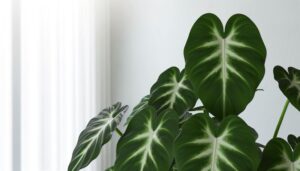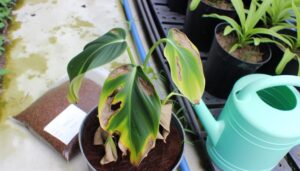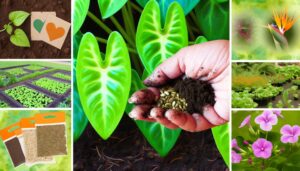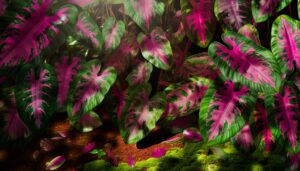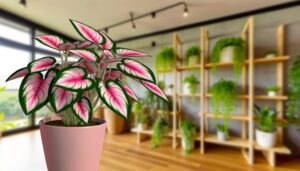What Is Philodendron Selloum Goeldii?
Philodendron Selloum Goeldii, part of the Araceae family, originates from South America's tropical rainforests. It features deeply lobed, glossy dark green leaves and a distinctive tree-like growth habit with a thick, woody stem.
This species thrives in bright, indirect light and well-draining, slightly acidic soil. Consistent, moderate watering and a balanced 20-20-20 fertilizer are essential for best growth.
However, vigilance against root rot, pests, and improper humidity levels is important. Successful propagation necessitates a humid environment and precise techniques.
For a detailed understanding, a closer examination of its care and propagation nuances is helpful.

Key Takeaways
- Philodendron Selloum Goeldii is a tropical plant from South America's rainforests.
- It features deeply lobed, glossy dark green leaves with prominent veins.
- The plant has a tree-like growth habit with a thick, woody stem and basal trunk.
- It thrives in bright, indirect light with well-draining, slightly acidic soil.
- Common issues include root rot, pest infestations, and inadequate humidity.
Origins and History
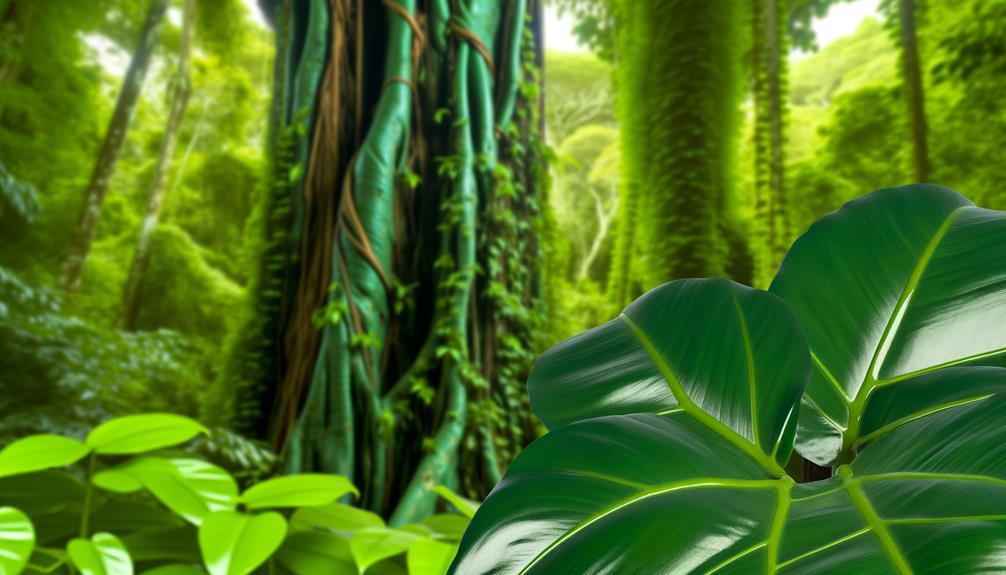
Philodendron Selloum Goeldii, named in honor of its discoverer Emilio Goeldi, traces its origins to the tropical rainforests of South America.
This species thrives in the understory layers of dense, humid forests, where it benefits from the filtered sunlight and rich, organic soil.
The plant's ecological niche involves symbiotic relationships with the surrounding flora and fauna, contributing to nutrient cycling and habitat complexity.
Historical records indicate that indigenous communities utilized the plant for various purposes, including medicinal applications and ornamental use.
Subsequent scientific explorations led to its formal classification within the Araceae family.
Today, Philodendron Selloum Goeldii is studied for its adaptability and ecological contributions, reflecting its enduring significance within its native habitat and beyond.
Unique Features
Philodendron Selloum Goeldii exhibits distinct leaf patterns characterized by deeply lobed, glossy green foliage that contributes to its ornamental value.
Additionally, its growth habit is notable for a robust, tree-like structure that allows it to reach impressive heights, making it a striking presence in both natural and cultivated environments.
These unique features are integral to its identification and differentiation within the Philodendron genus.
Distinct Leaf Patterns
Characterized by deeply lobed and intricately divided leaves, Philodendron Selloum Goeldii exhibits a unique foliage pattern that distinguishes it from other species within the genus.
The leaves are typically large, reaching up to 18 inches in length, and display a pinnate structure with multiple elongated lobes. Each lobe is finely serrated, contributing to the plant's complex and visually striking appearance.
The leaf surface is glossy and dark green, often showing prominent venation that enhances the pattern's aesthetic appeal. This distinctive morphology not only aids in maximizing photosynthetic efficiency but also serves as an adaptation to the plant's natural habitat.
Such intricate leaf architecture makes Philodendron Selloum Goeldii a prized specimen among botanists and horticulturists alike.
Growth Habit Characteristics
Notable for its robust and upright growth habit, Philodendron Selloum Goeldii develops a thick, woody stem that can reach heights of up to 6 feet, providing structural support for its expansive foliage. This arborescent species displays a substantial basal trunk, allowing it to develop a tree-like appearance over time. The leaves, deeply lobed and glossy, emerge from petioles that radiate from the stem, contributing to a symmetrical and aesthetically pleasing canopy. Additionally, Philodendron Selloum Goeldii exhibits aerial roots, which aid in nutrient absorption and provide additional anchorage.
| Feature | Description | Function |
|---|---|---|
| Stem | Thick, woody, up to 6 feet | Structural support |
| Leaves | Deeply lobed, glossy | Aesthetic appeal, photosynthesis |
| Basal Trunk | Substantial | Tree-like growth |
| Petioles | Radiating from stem | Leaf support |
| Aerial Roots | Present | Nutrient absorption, anchorage |
Ideal Growing Conditions
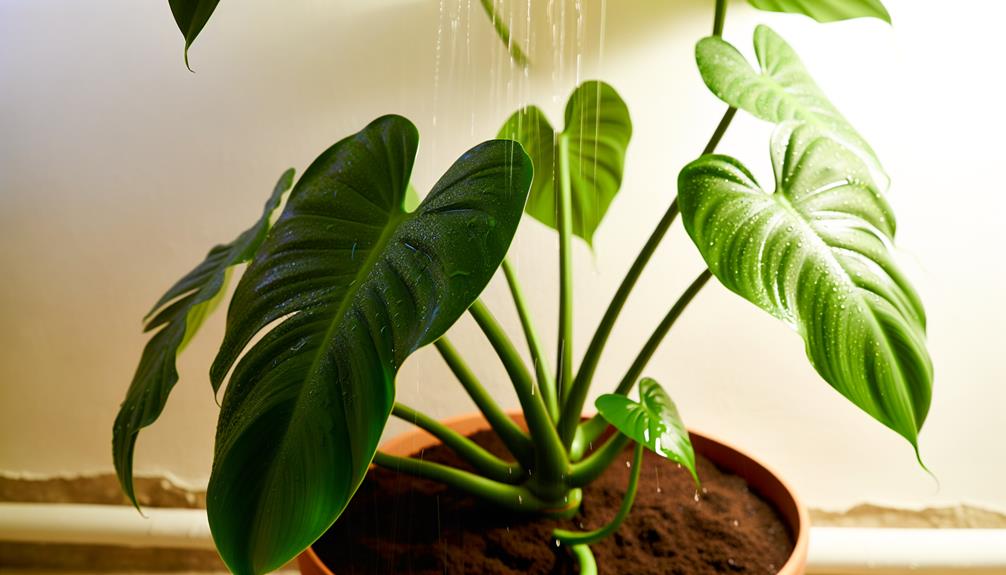
Understanding the ideal growing conditions for Philodendron Selloum Goeldii is vital for peak plant health and development. The plant thrives in environments with specific light and temperature ranges, as well as precise soil composition and watering practices.
This section will examine the necessary light exposure, temperature tolerance, soil requirements, and hydration needs to promote robust growth.
Light and Temperature
Philodendron Selloum Goeldii thrives in bright, indirect light and requires a stable temperature range between 65°F and 80°F for best growth. This plant's photosynthetic efficiency is maximized under these conditions, promoting robust foliage development and overall health. Exposure to direct sunlight can lead to photodamage, manifesting as scorched leaves.
To enhance its environment:
- Light: Place the plant near a north or east-facing window, ensuring it receives ample, diffused light.
- Temperature: Maintain indoor temperatures consistently within the specified range to prevent thermal stress.
- Humidity: Keep relative humidity levels between 60% and 70% to mimic its natural tropical habitat.
These conditions collectively foster an ideal microenvironment for Philodendron Selloum Goeldii, ensuring peak physiological functioning and aesthetic appeal.
Soil and Watering
In addition to ideal light and temperature conditions, proper soil composition and watering practices are fundamental to the successful cultivation of Philodendron Selloum Goeldii.
The soil must be well-draining, rich in organic matter, and slightly acidic to neutral (pH 5.5-7). A mix containing peat, perlite, and pine bark is recommended to promote aeration and prevent root rot.
Watering should be consistent yet moderate; the soil must remain moist but not waterlogged. It is essential to allow the top inch of soil to dry out between waterings to avoid overhydration.
Additionally, utilizing a pot with drainage holes makes sure excess water can escape, further mitigating the risk of root diseases. Proper irrigation and soil management are key to robust growth.
Watering and Feeding
Proper hydration and nutrient delivery are crucial for the healthy growth and vibrant foliage of Philodendron Selloum Goeldii. This species thrives in consistently moist soil, yet waterlogging must be avoided to prevent root rot.
The plant benefits from a balanced, water-soluble fertilizer during its active growing season. Specifically, consider the following guidelines:
- Watering Frequency: Maintain soil moisture by watering when the top inch of soil feels dry, typically every 7-10 days.
- Fertilization Schedule: Apply a balanced 20-20-20 fertilizer bi-weekly from spring through early autumn for best nutrient uptake.
- Water Quality: Utilize distilled or rainwater to avoid mineral buildup, which can negatively impact plant health.
These practices promote strong growth and lush, green foliage.
Common Issues
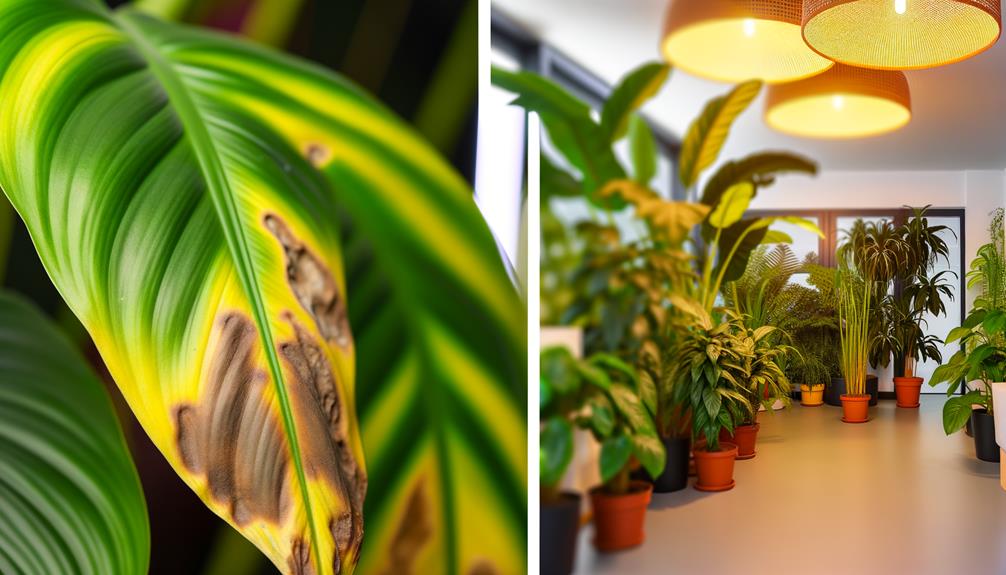
While proper watering and feeding are fundamental for the health of Philodendron Selloum Goeldii, understanding common issues that may arise is equally important for maintaining its ideal condition.
One prevalent issue is root rot, typically caused by overwatering or poor drainage. Symptoms include yellowing leaves and a foul odor emanating from the soil.
Another frequent problem is pest infestations, such as spider mites and aphids, which can lead to leaf discoloration and stunted growth.
Additionally, inadequate humidity levels can result in brown leaf tips, a condition known as tip burn.
Monitoring soil moisture, maintaining appropriate humidity, and conducting regular inspections for pests are essential measures to avert these complications and guarantee the plant thrives.
Propagation Tips
Propagation of Philodendron Selloum Goeldii can be effectively achieved through stem cuttings, ensuring the selection of healthy, disease-free parent plants for best results.
The process involves several critical steps:
- Cutting Selection: Choose a stem with at least two nodes. Utilize sterilized pruning shears to minimize the risk of pathogen transmission.
- Preparation: Remove any leaves near the cut end. Dip the cut end into rooting hormone to stimulate root development.
- Planting: Insert the cutting into a well-draining soil mix. Maintain a humid environment by covering with a plastic bag or placing in a propagation chamber.
These steps, executed with precision, will enhance the likelihood of successful propagation, promoting robust growth in new plants.
Conclusion
Philodendron selloum Goeldii, a botanical wonder, weaves a lush tapestry with its distinct foliage and strong adaptability. Originating from tropical regions, this species flourishes in carefully balanced conditions of light, moisture, and nutrients.
Its growth story, characterized by strength and energy, offers a symphony of green shades, enchanting plant enthusiasts. Understanding its cultivation complexities, from watering to propagation, reveals a world where nature's creativity and scientific accuracy harmoniously come together, forming a living proof of botanical grace.

